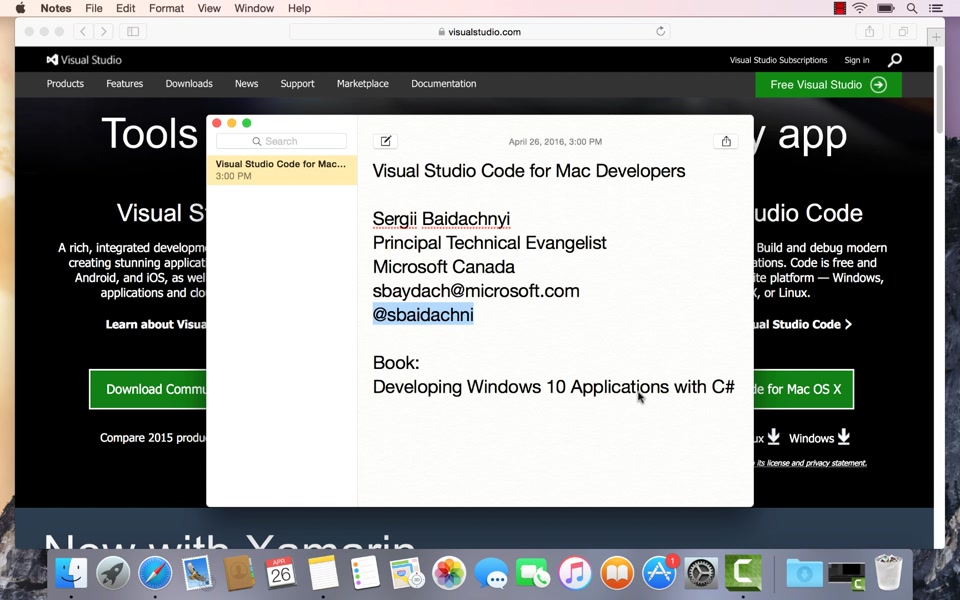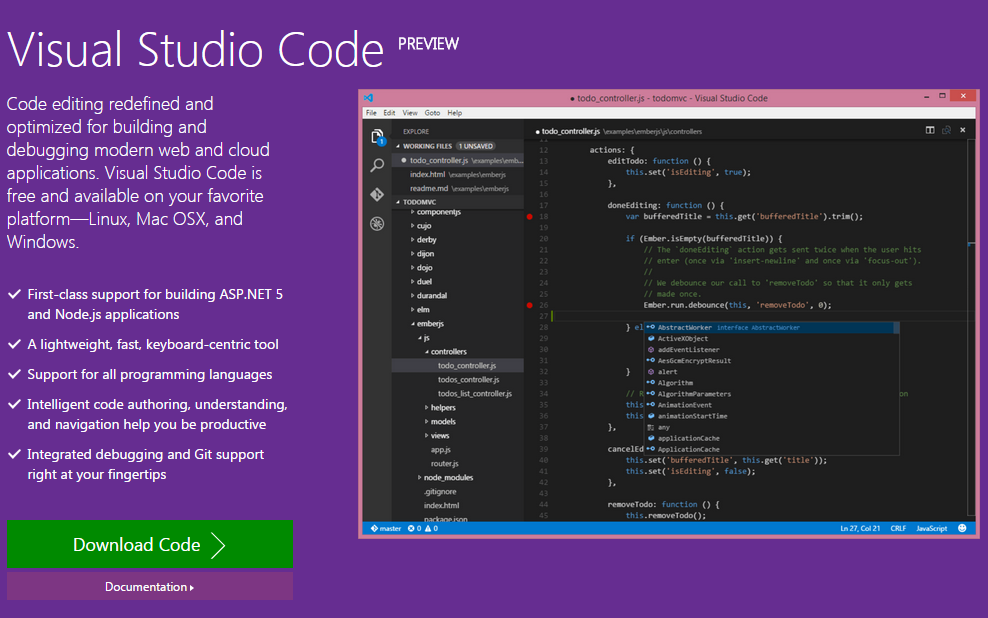Just to be clear: I don't want any Windows VM's running on the Mac, the machine are stand-alone desktops or laptops. I created 2 different accounts on the Mac, one for each of the Windows machines connecting through Visual Studio. Then I started one iOS simulator on Windows, everything went fine. Using VSTS (GIT) on Windows and Mac at the same time? As I’m not only doing Windows development these days, I have a need for hosting my source code somewhere common. I do not want to setup two different systems just because I happen to be developing in two worlds (.NET and Apple). Use Visual Studio, a fully-featured and extensible IDE on Windows. Or, use Visual Studio for Mac, a rich IDE for macOS. Both offer UI designers, efficient code editing, debugging and publishing tools, and more. With regards to nuget, I have a shared Xamarin.Forms project. In VS Windows, I go up to solution in the explorer, right click, and can manage my nuget packages. I can add, update, and remove to my heart's content. In VS Mac, I select my solution, and I can't add any nuget packages. I can only Update & Restore. So, I can't add them in VS.Mac.
Visual Studio For Mac
And, since Visual Studio for Mac uses the same MSBuild solution and project format as Visual Studio, developers working on Mac and Windows can share projects across Mac and Windows transparently.
Microsoft’s Connect developer conference kicked off Wednesday with some expected news: The next versions of the Visual Studio IDE have arrived on Windows and Mac. (Yep, you read that right.)
After a set of leaks from MSDN Magazine on Monday, the company officially confirmed Wednesday morning that it’s bestowing the Visual Studio brand on Xamarin Studio, a C# development environment for the Mac that the company acquired earlier this year when it bought the company of the same name. In addition, Microsoft’s confusingly named Visual Studio “15” has been officially renamed Visual Studio 2017 and given a release candidate at the show.
Microsoft also launched Visual Studio Mobile Center, a portal for developers to access a suite of services all aimed at making it easier to create mobile apps.
Visual Studio For The Mac
The moves are part of Microsoft’s ongoing push to expand the reach of its developer tools and improve what they’re capable of. The C# programming language and .NET frameworks are widely used, but also compete with a wide variety of other programming tools. By expanding the capabilities available to developers who already know those tools, Microsoft is making them more relevant.
The Visual Studio for Mac rebranding doesn’t confer any new features that weren’t already available in Xamarin Studio. But Microsoft sees the Xamarin name as synonymous with mobile development, which is only one of the things the Mac IDE is capable of. Thanks to Microsoft’s open sourcing of its .NET programming framework, Visual Studio for Mac is able to access some of the same tools and services used by the Windows version of Visual Studio, like the Roslyn compiler, the MSBuild build platform and the IntelliSense code-completion system.
It will be interesting to see how Microsoft improves Visual Studio for Mac going forward. The company has typically taken a somewhat uneven approach to supporting the Mac with its Office productivity suite, and there typically isn’t feature parity between one version of Word and another.
It seems likely that the company won’t offer the exact same features on Visual Studio for Mac and Windows, but there’s still some question about what the difference between the two platforms will be.
The Visual Studio 2017 release candidate on Windows is a sign that Microsoft thinks the next version of its Windows development environment is nearing completion. It’s been around as Visual Studio “15” (yes, with the quotes) for about half a year after Microsoft Build earlier this year.

On top of its desktop IDEs, Microsoft supports a wide variety of different mobile development services, like the Xamarin Test Cloud, which lets developers see how their apps run on a wide variety of mobile devices, and HockeyApp, a tool for deploying beta versions of mobile apps. The company is taking all of those tools and rolling them up into the Visual Studio Mobile Center.
The portal could be a boon for both developers and Microsoft. The tech giant has acquired and launched a whole host of differently named services, all aimed at helping developers be more productive. Giving them a one-stop shop to find all of those tools could increase usage.
All of this news is part of a massive suite of announcements that the company made Wednesday at its Connect conference. Microsoft also revealed that it’s now a part of the Linux Foundation, and announced that Google joined the .NET Foundation.
reader comments
with 60 posters participatingOn Wednesday, Microsoft is hosting its Connect() developer conference in New York City, but the company has accidentally let slip a couple of pieces of news a bit early. Posts were published to MSDN Magazine (though they've now been removed) earlier than intended.

The biggest news is that Visual Studio is coming to the Mac—or, at least, a piece of software named Visual Studio is coming to the Mac. Microsoft has always had a surprising willingness to give different products similar names, a move that generally provokes more confusion than it does enlightenment. The same seems true here.

Visual Studio for Mac isn't, in fact, Visual Studio at all. Instead, it's the latest iteration of Xamarin Studio, the cross-platform C# development environment that Microsoft inherited when it bought Xamarin, developers of cross-platform .NET-based mobile development tools, last year.
These are two very different products, and the real Windows Visual Studio is the more capable product. However, the two offerings are less different than they once were. Even without Microsoft's ownership of the company, the Xamarin platform was set to align more closely with the .NET platform thanks to Microsoft's open sourcing efforts: many components that Xamarin had to develop independently could be dropped in favor of the 'real' .NET versions. In particular, the Roslyn C# compiler and MSBuild build tool and project files are shared between real Visual Studio and the new Visual Studio for Mac. The interface designers for building Android and iOS apps using the Xamarin platform are also shared. This means that if a project builds in one, it will build in the other. Thus, developers on different platforms can easily contribute to the same projects; teams can in principle be made of a mix of Windows and Mac developers.
For those wanting something a little lighter weight, Microsoft's other weirdly branded product, Visual Studio Code (which, again, has no real shared heritage with 'Visual Studio'), remains a cross-platform text editor and simple development environment.
Visual Studio For Mac Tutorial
MSDN Magazine also spoiled a little snippet of news about the real Visual Studio. Hitherto, the development of the next version of Visual Studio has used the awkward name Visual Studio '15,' quote marks and all. With the current version being 'Visual Studio 2015,' this made it all too easy to stumble and refer to the wrong one by accident. But '15' now has a proper name: it will be 'Visual Studio 2017.' It's still not finished, but a release candidate will be released at the Connect event.
Visual Studio For Mac Wikipedia
Visual Studio 2017 contains a laundry list of new, incremental improvements to C++, C#, F#, debugging, and more. In some ways, its biggest improvement is not to the core product itself but its installer. Currently installing and updating Visual Studio is a tremendously tedious affair that takes far longer than seems reasonable. Uninstalling is also aggravating, as many of the dependencies have to be removed separately. The new installer promises to be faster, allowing smaller installations that only include the features you need and enabling clean one-shot uninstallation.